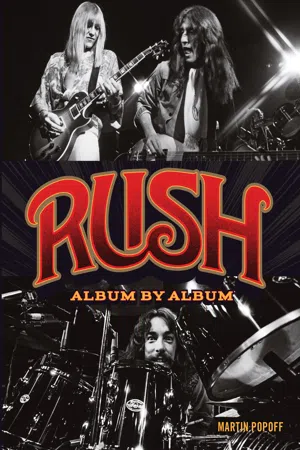
- 192 pages
- English
- ePUB (mobile friendly)
- Available on iOS & Android
About this book
Rush: Album by Album pays genuine tribute to this iconic rock band's discography by moderating frank, entertaining conversations about all 20 of Rush's studio albums.
Formed in Toronto in 1968, the rock trio Rush has gone on to multiplatinum success behind the distinctive high register and virtuosic bass-playing of frontman Geddy Lee, the legendary drumming and lyric-writing of Neil Peart, and the guitar heroics of Alex Lifeson. Despite having just four chart-topping singles since the release of their debut LP in 1974, Rush has nonetheless sold more than 25 million albums in the U.S. and more than 40 million worldwide.
The Canadian trio may be the definition of an "album band," and this new book from prolific rock journalist and acknowledged Rush authority Martin Popoff pays tribute to the band's discography by moderating in-depth, frank, and entertaining conversations about all 20 of Rush's studio albums. Inside, the author gathers 20 rock journalists and authors who offer insights, opinions, and anecdotes about every release.
Together, the conversations comprise a unique historical overview of the band, as well as a handsome discography. Popoff also includes loads of sidebars that provide complete track listings, details on album personnel, information on where and when the albums were recorded, and sidebar facts about the albums, their songs, and the band.
Frequently asked questions
- Essential is ideal for learners and professionals who enjoy exploring a wide range of subjects. Access the Essential Library with 800,000+ trusted titles and best-sellers across business, personal growth, and the humanities. Includes unlimited reading time and Standard Read Aloud voice.
- Complete: Perfect for advanced learners and researchers needing full, unrestricted access. Unlock 1.4M+ books across hundreds of subjects, including academic and specialized titles. The Complete Plan also includes advanced features like Premium Read Aloud and Research Assistant.
Please note we cannot support devices running on iOS 13 and Android 7 or earlier. Learn more about using the app.
Information
CHAPTER 1
RUSH



Table of contents
- Cover
- Title Page
- Contents
- Introduction
- 1 Rush
- 2 Fly by Night
- 3 Caress of Steel
- 4 2112
- 5 A Farewell to Kings
- 6 Hemispheres
- 7 Permanent Waves
- 8 Moving Pictures
- 9 Signals
- 10 Grace Under Pressure
- 11 Power Windows
- 12 Hold Your Fire
- 13 Presto
- 14 Roll the Bones
- 15 Counterparts
- 16 Test for Echo
- 17 Vapor Trails
- 18 Feedback
- 19 Snakes & Arrows
- 20 Clockwork Angels
- Contributors
- Author Bibliography
- Index
- Copyright